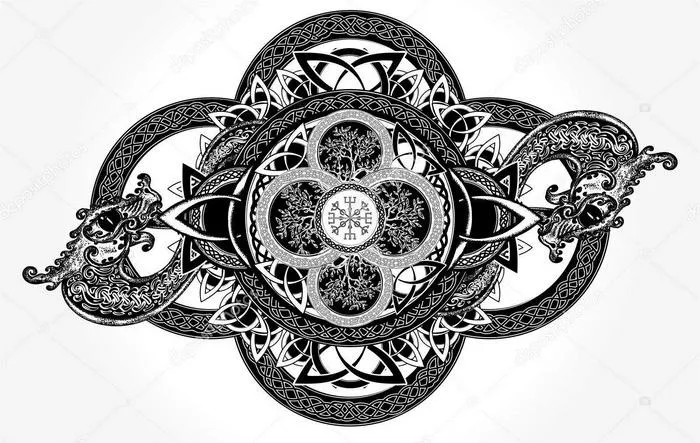Tattoos have been an enduring form of expression, deeply rooted in cultural traditions across civilizations and epochs. Among the enigmatic ancient cultures, the Celts stand out for their rich tapestry of art, mythology, and societal customs. Delving into the realm of Celtic civilization, one intriguing question arises: Did Celtic people adorn their faces with tattoos? Exploring historical evidence, cultural significance, artistic representation, modern interpretations, and misconceptions unravels the complexities of this inquiry.
Historical Evidence
Unearthing the remnants of ancient Celtic society often presents a fragmented puzzle, with archaeological findings serving as vital pieces. While direct evidence of facial tattoos among the Celts is scarce, some archaeological discoveries and historical accounts provide tantalizing glimpses into their tattoo practices.
In 1993, the discovery of the mummified remains of the “Ukok Princess” in the Altai Mountains of Siberia shed light on ancient tattooing practices. Though not Celtic herself, the intricate tattoos adorning her body, including her face, sparked scholarly speculation about tattooing in contemporary cultures, including the Celts. Furthermore, artifacts such as the “Pazyryk Carpet,” found in the same region and dating back to around 400 BCE, depict individuals with elaborate tattoos, suggesting a widespread tradition of body modification in ancient Eurasian societies, possibly including the Celts.
Ancient texts, notably those of Greek and Roman historians, offer glimpses into Celtic customs. Julius Caesar’s “Commentarii de Bello Gallico” mentions the Celts’ penchant for body art, describing them as dyeing their bodies with woad, a plant-based pigment, for both decorative and ritualistic purposes. While Caesar’s accounts primarily focus on body painting rather than permanent tattoos, they hint at a culture deeply engaged with bodily adornment.
Cultural Significance
In Celtic society, tattoos likely held multifaceted significance, intertwining with religious, social, and personal realms. The Celts revered nature and the spiritual forces they believed inhabited it, infusing their art with symbolism reflective of their animistic beliefs. Tattoos, as expressions of this spiritual connection, might have conveyed protection, strength, or allegiance to specific deities.
Moreover, tattoos could have denoted social status or marked important life events such as coming of age or marriage. In a society where oral tradition held sway and written records were scarce, tattoos could have served as visual narratives, inscribing one’s life story onto the canvas of the body.
Artistic Representation
While direct evidence of Celtic face tattoos is elusive, artistic representations offer tantalizing insights into their possible appearance. Intricate metalwork, such as the La Tène style artifacts found across Europe, showcases swirling motifs reminiscent of Celtic knotwork and zoomorphic designs. Imagining these patterns translated onto skin evokes a vision of mesmerizing facial adornments, blending seamlessly with the wearer’s features.
Additionally, the intricate interlace patterns found in illuminated manuscripts like the Book of Kells provide further inspiration for conjecturing about Celtic tattoo aesthetics. These meticulously crafted designs, characterized by their intricate knotwork and vibrant colors, hint at a visual language ripe for translation onto the human form.
Modern Interpretations
Contemporary Celtic tattoos draw inspiration from historical motifs while embracing modern techniques and sensibilities. Tattoo artists adeptly reinterpret ancient designs, imbuing them with personal meaning or updating them to suit contemporary tastes. Celtic knotwork, spirals, and animal motifs remain popular choices, symbolizing concepts such as eternity, growth, and connection to nature.
However, modern Celtic tattoos often diverge from their ancient counterparts in execution and symbolism. While ancient tattoos may have been imbued with spiritual and social significance, modern interpretations are often chosen for their aesthetic appeal or personal resonance. Additionally, advancements in tattooing technology and the availability of a wide range of pigments allow for greater artistic freedom and customization.
Misconceptions
Despite their enduring allure, Celtic tattoos are not immune to misconceptions and misinterpretations. One common fallacy is the conflation of Celtic tattoos with war paint or other forms of temporary body decoration. While Celtic warriors may have adorned themselves with paint or dye before battle for intimidation or ritualistic purposes, tattoos represented a more permanent form of self-expression, deeply ingrained in cultural and spiritual practices.
Furthermore, the notion of a monolithic “Celtic tattoo” fails to capture the diversity and complexity of Celtic art and culture. The Celts were a diverse group of peoples spread across a vast geographical area, each with its own distinct artistic traditions and cultural practices. Thus, attempting to encapsulate Celtic tattooing in a singular, static image does a disservice to the dynamic and multifaceted nature of Celtic civilization.
In conclusion, the question of whether Celtic people had face tattoos invites us to embark on a journey of exploration through the annals of history, archaeology, and art. While direct evidence may elude us, the tantalizing glimpses provided by archaeological findings, cultural context, artistic representation, modern interpretations, and misconceptions offer valuable insights into the rich tapestry of Celtic tattooing practices. As we peel back the layers of time, we come to appreciate the enduring legacy of Celtic artistry and the timeless allure of the tattoo as a form of self-expression and cultural identity.

